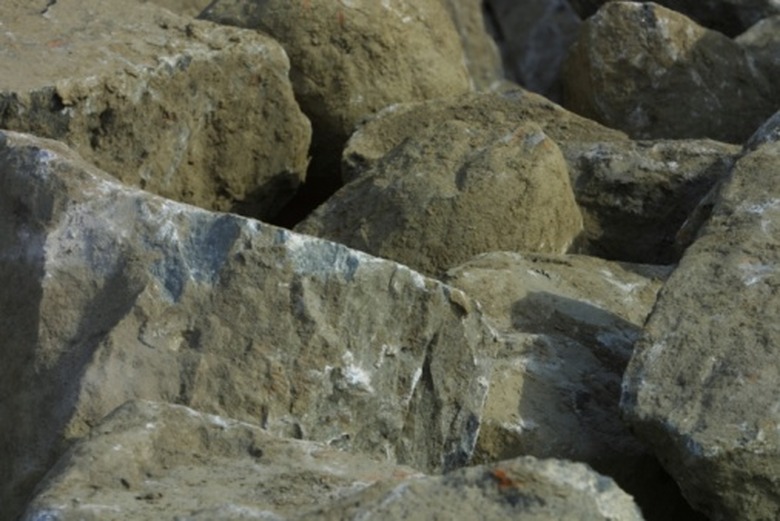Differences Between Foliated & Non-Foliated Metamorphic Rocks
What are some of the differences between foliated rocks and nonfoliated rocks? In geology, key terms related to metamorphic rocks include foliated and nonfoliated. Metamorphic rocks are those that begin as some other kind of rock, whether it's igneous, sedimentary or another metamorphic rock. The parent rock that undergoes metamorphism is called the protolith.
Protoliths are transformed chemically and physically by high temperatures, high pressures, hot fluids or some combination of these conditions. Foliated metamorphic rocks exhibit layers or stripes caused by the elongation and alignment of minerals in the rock as it undergoes metamorphism. In contrast, nonfoliated metamorphic rocks do not contain minerals that align during metamorphism and do not appear layered.
Types of Foliated Metamorphic Rocks
Types of Foliated Metamorphic Rocks
A rock list of types of foliated metamorphic specimens includes gneiss, schist, phyllite and slate. Specific patterns of foliation depend on the types of minerals found in the original rock, the size of the mineral grains and the way pressure is applied to the rock during metamorphosis.
One kind of foliation is called gneissic banding, which looks like bands of light and dark layers. Any rock that contains more than one kind of mineral can be the protolith for gneiss, which is the name for a metamorphic rock that exhibits gneissic banding.
Another type of foliated metamorphic rock is called schist. With aligned minerals that are coarse enough to see, rocks that exhibit schistose foliation sparkle, because they contain micas that reflect light. The protolith for a schist is usually shale, a type of sedimentary rock.
Phyllite is a third type of foliated metamorphic rock. With wavy layering known as phyllitic foliation, these rocks often have a silky or satiny sheen, which is caused by the arrangement of very fine minerals that form as a result of the pressure applied during metamorphism.
A fourth type of foliated metamorphic rock is called slate. Slate exhibits slaty foliation, which is also called cleavage. In geology, cleavage refers to the tendency of a rock to break parallel to the alignment of the tiny mica minerals it is composed of. This means that slate breaks into thin layers, which have economic value as tiles and blackboards. The protolith for slate is shale, and sometimes fossils that were present in the original rock can be seen in freshly sheared layers of slate.
Types of Nonfoliated Metamorphic Rocks
Types of Nonfoliated Metamorphic Rocks
Composed of minerals that do not elongate or align during metamorphosis, nonfoliated metamorphic rocks tend to be simpler than foliated rocks. Examples of nonfoliated metamorphic rocks include marbles, quartzites and soapstones. Granofels is a broad term for medium- to coarse-grained metamorphic rocks that do not exhibit any specific foliation.
Marble is made of dolomite or calcite, and they result from the metamorphism of limestone or dolostone. A hard rock that is easy to carve, marble is often used to make floor tiles, columns and sculptures.
A second type of nonfoliated metamorphic rock, quartzite, is composed mostly of silicon dioxide. The protolith for quartzite is quartz, and because quartz is stable under high pressure and high temperatures, metamorphism of this rock simply causes the reorganization of its crystals. A very hard rock, quartzite is often used to make kitchen countertops and floor tiles.
Soapstones are another type of nonfoliated metamorphic rock. Rich in talc, soapstones feel greasy, like soap. Soapstone is a relatively soft metamorphic rock and absorbs and holds heat well, so it is often used around fireplaces and woodstoves. Easy to carve, soapstone was traditionally used by Native Americans for making tools and implements.
There are many other types of specific nonfoliated metamorphic rocks, such as greenstone, eclogites and serpentines. Created by unique combinations of minerals and metamorphic conditions, these rocks are classified by their chemical compositions.
Cite This Article
MLA
Sloane, Christina. "Differences Between Foliated & Non-Foliated Metamorphic Rocks" sciencing.com, https://www.sciencing.com/differences-between-foliated-non-foliated-metamorphic-rocks-13406863/. 20 October 2021.
APA
Sloane, Christina. (2021, October 20). Differences Between Foliated & Non-Foliated Metamorphic Rocks. sciencing.com. Retrieved from https://www.sciencing.com/differences-between-foliated-non-foliated-metamorphic-rocks-13406863/
Chicago
Sloane, Christina. Differences Between Foliated & Non-Foliated Metamorphic Rocks last modified August 30, 2022. https://www.sciencing.com/differences-between-foliated-non-foliated-metamorphic-rocks-13406863/
